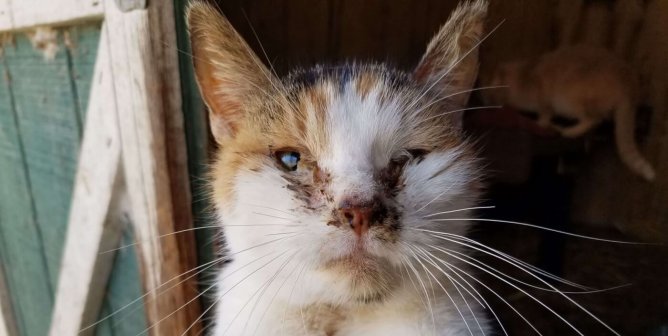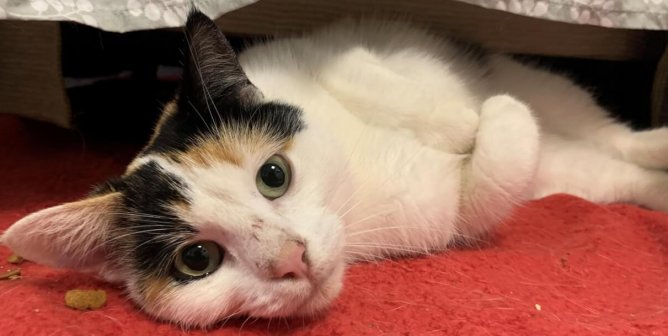Facts on Ferrets
Ferrets are domesticated animals whose ancestors are believed to be native European polecats (Mustela putorius). Inquisitive, smart, and playful, they’ve become popular companion animals, but they require special food and care.1 Often, after the novelty of an impulse purchase wears off, ferrets are abandoned to certain death outside or sent to severely crowded animal shelters.
Adoption
Ferrets are social and affectionate and should always live with a companion of their own species. If you’re ready to make a lifetime commitment (up to 10 years) to a pair of ferrets, first make sure you live in an area where they’re allowed. California and Hawaii both have bans on keeping ferrets as companion animals, and some local communities, such as New York City, have either restrictions or a ban on keeping ferrets in homes.2,3 Ask your local humane society or veterinarian about the legality of keeping ferrets where you live and whether you’ll need to obtain a permit if you adopt a pair.
You’ll want to adopt from an open-admission animal shelter or a ferret rescue group. Pet stores sell ferrets who were likely raised in filthy, disease-ridden breeding mills and are often sick or injured. The stores frequently deny these animals needed medical care, instead forcing them to continue to suffer because, as the manager of one PetSmart store told a PETA eyewitness, “There’s no point in me paying that for a $15 animal.”
Ferrets can usually coexist peacefully and even amicably with cats and dogs. However, they shouldn’t be allowed free access to smaller companions such as birds or rodents, as they prey on them in nature. If you have young children, be sure to monitor their interactions with the ferrets very closely. If ferrets feel threatened, they may bite in self-defense.
Ferret-Proofing
To ensure your ferrets’ safety and well-being, you’ll need to examine and ferret-proof your home, as a few items are tempting and potentially dangerous:
- Cabinets and drawers, which ferrets can open
- Heaters, which can be knocked over
- Furnace ducts that ferrets can get inside
- Recliners and sofa beds, as animals have been crushed in their levers and springs
- Things that are spongy or springy, such as kitchen sponges, erasers, shoe insoles, foam earplugs, Silly Putty, foam rubber (including inside a cushion or mattress), Styrofoam, insulation, and rubber door stoppers, which are fun to chew on and may cause an intestinal blockage if swallowed
- Filled bathtubs, toilets, and water and paint buckets, which are drowning hazards
- Plastic bags, which can cause suffocation
- Holes behind refrigerators and other appliances with exposed wires, fans, or insulation, all of which are tempting to chew on
- Appliances that ferrets can become trapped inside, including dishwashers, refrigerators, washers, and dryers
- Houseplants, which may be poisonous
- Box springs, as ferrets love to rip the cloth covering the underside and climb in, where they may be trapped or crushed (To prevent this, attach wire mesh or thin sheets of wood to the underside of the box springs.)
Housing
Even if you plan to let your ferrets explore the house freely at times, when you’re not home, it’s best to enclose them in a ferret-proof room or in a spacious metal mesh cage. The MidWest Homes for Pets Ferret Nation Enclosed Habitat is a great example of an adequate enclosure for up to three ferrets—note the living space’s sleeping areas and multiple levels. The animals also enjoy having ramps; tunnels, which can be bought in cloth versions or made from PVC-type piping; a “bedroom,” which can be a simple upside-down box with a cut-out doorway; and sleeping hammocks. Line the cage bottom with cloth cage pads, and use old T-shirts and sweatshirts for bedding—never use cedar or pine shavings, which are toxic to small animals. The bedding can be laundered with unscented detergent, and the bottom of the cage should be cleaned with vinegar to kill bacteria and eliminate odors.
The temperature in their living quarters needs to stay fairly consistent, and the humidity should be at the proper level. In the winter, when the heat is on and humidity gets low, ferrets’ skin can get dry and itchy, so a humidifier can help. If the humidity is allowed to get too high during the summer and the temperature rises above 85 degrees, ferrets can succumb to heatstroke. In nature, they live in underground burrows where the temperature is 55 degrees with 50% humidity.4
Litter Training
Ferrets can easily be trained to use a litterbox. They tend to choose their own toilet area, so start by putting a litterbox with paper pulp litter in that area and gradually move it closer and closer to where you’d like it to be. Ferrets love corners for their bathroom areas, so if the litterbox can stay in a corner, you will likely have greater success. You’ll want to avoid clay litter (as it’s too dusty for them) and clumping litter (which can stick to their anus, nose, and eyes). Paper-based litter is best, as it’s the least tempting for them to nibble on.
Diet
Ferrets are predators and strict carnivores and therefore require highly digestible, meat-based proteins. They can’t survive on vegetarian diets or most dog foods, as the carbohydrate levels are too high for them, which can create health problems.
If you feed them dry kibble, be sure that the food contains at least 30% to 40% crude protein (of animal origin) and 15% to 20% fat. A thorough reading of the label is crucial—the first few ingredients should be meat-based.5 Avoid processed treats marketed for ferrets, as they tend to be carbohydrate- or grain-based. Supplements shouldn’t be necessary if the animal has an optimal diet. For more details, check out “Rethinking the Ferret Diet” by Dr. Susan Brown.
Overall Health
Ferrets require routine veterinary visits, as all companion animals do. If you live in an area where rabies shots are required for dogs and cats, your ferret will need one, too. They can also get heartworms, fleas, and distemper, so you should consult your veterinarian about preventive measures. (But never use dips, sprays, or collars to combat fleas.)
These animals can be spayed or neutered at 4 months old—this is necessary in order to prevent reproduction as well as for their well-being. Neutering greatly decreases a male’s body and urine odor once he matures and prevents him from urine-marking his territory in your home. Spaying also reduces a female’s scent and prevents her from dying of severe anemia, which can develop in intact females who go into heat but don’t breed.6
Ferrets generally need their nails trimmed every six to eight weeks. A veterinary office can do the trimming or train you on the proper method.
Exercise is also important. You can accommodate your ferret’s need for burrowing and hunting with toys like large cardboard mailing tubes, dryer hoses, paper bags, PVC pipe, ping-pong balls, golf balls, and small cloth baby toys or cat toys that hang from strings. Be sure to let your ferrets play outside of their cage for at least several hours every day.
Ferrets are affectionate animals, so if you give them the care, attention, and love that they need, they’ll likely develop a close bond with the whole family.
References
1Jessica Duda, “Mustela putorius furo—Domestic Ferret,” Animal Diversity Web, accessed 10 May 2018.
2Alex Distefano, “Culver City Woman Leads Fight to Make Ferrets Legal Pets in California,” LA Weekly, 2 Apr. 2018.
3Aaron Short, “NYC Fails to Overturn Ferret Ban,” New York Post, 10 Mar. 2015.
4Susan Brown, “Ferret Grooming,” Small Mammal Health Series, 5 Dec. 2011.
5Susan Brown, “The Ferret Diet,” Small Mammal Health Series, 14 Mar. 2001.
6Natalie Antinoff, “Anemia in Ferrets: Clinical Case Challenges (Proceedings),” CVC in Kansas City Proceedings, 1 Aug. 2009.








